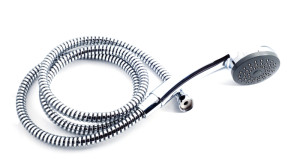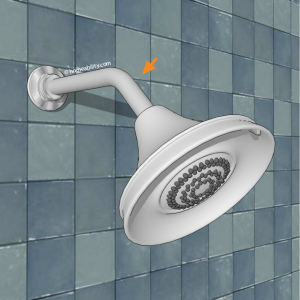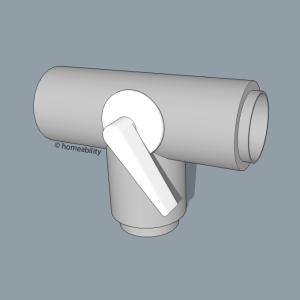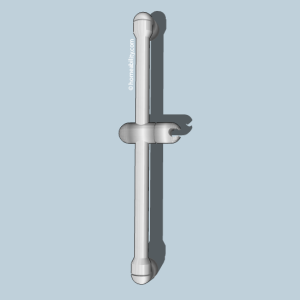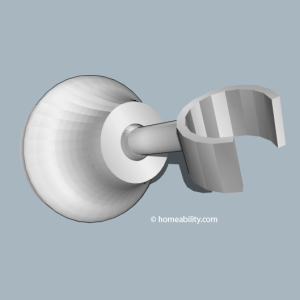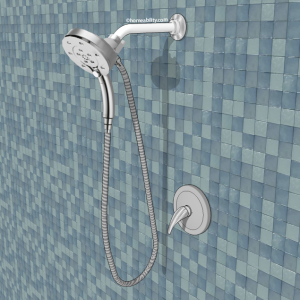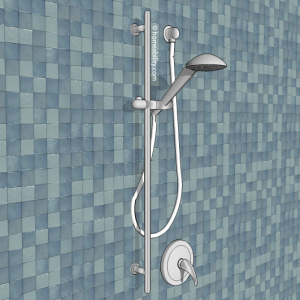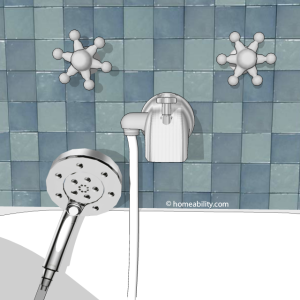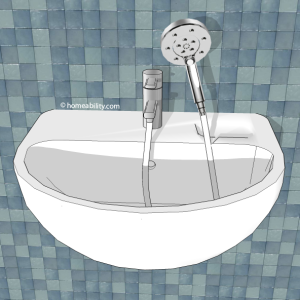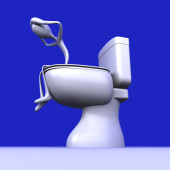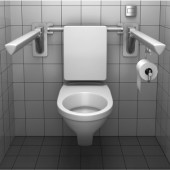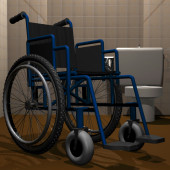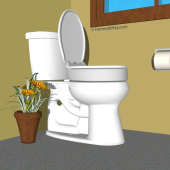Handheld Showerhead Guide: The Basics
What is a Handheld Showerhead?
A handheld showerhead (aka Adjustable Shower Head or Shower Spray Unit) consists of a long, flexible hose with a showerhead attached at one end. The other end is attached to a nearby water outlet, which can include the water supply for a standard showerhead, the tub spout, or a sink faucet.
Benefits of a Handheld Showerhead
A handheld showerhead makes it easier…
- for a user to perform bathing tasks from a seated position
- for a caregiver to assist someone else with bathing
- for parents to bathe children
- pet owners to bathe pets
- to rinse down the shower after use
A Dizzying Number of Options!
A handheld showerhead is a rather simple product, yet for all its simplicity there are a surprising number of different types, styles, and options. The key differences lie in where they are designed to be attached (shower arm, bathtub spout, sink faucet, or diverter valve) and in the type of parts included with the unit.
In this guide, we provide an overview of the different handheld showerhead options, beginning with a quick description of the parts involved, followed by a list of handheld showerhead types, and at the end you’ll find a list of things to take into consideration to aid you in selecting the best type for your bathroom and needs.
Understanding the Parts
To start, it will be helpful for you have a basic understanding of the terminology and the parts involved in order to pick the one best suited for your home and needs. If you aren’t inherently handy, don’t worry! It’s not hard. Aside from the showerhead and the hose it is attached to, there are four other parts its helpful for you to know, which include: shower arm, diverter valve, vertical slide bar, and shower head holder.
1. SHOWER ARM
2. THREE-WAY DIVERTER VALVE
3. VERTICAL SLIDE BAR
4. SHOWERHEAD HOLDER
Handheld Showerhead Parts Amazon.com
Handheld Showerhead: Types & Options
Handheld showerheads come in a number of different types and can include a variety of different parts that may be mixed-and-matched together in different ways. We have provided a list of the most common options below.
Handheld Showerheads Amazon.com
Handheld Showerhead: Features
It is important to not only choose the general “type” of handheld shower head, as covered in the list above, but to also pay close attention to the features the shower head includes to ensure they meet your needs as well. In the list below, we have provided an overview of some of the features handheld shower models can offer.
- Location of On/Off Control: Some handheld showerhead models are designed to be operated via the standard shower controls located on the front wall of the shower, while other models have an on/off switch (or pause button) located on the showerhead itself. The latter type, ones with an on/off switch on the showerhead itself make it much easier for a seated user to control the water, especially in cases where the shower seat is not located within easy reaching distance of the shower controls.
- Vertical Slide Bar/Grab Bar: In most instances, the vertical slide bars that are included with handheld showerhead kits are not intended for use as a grab bar. There are a small percentage of models that are equipped with vertical slide bars which have been specially designed to dual as a grab bar as well, meaning that when they are installed correctly they can be used by bathers for support when stepping in and out of the shower or tub.
- Handle/Safety Straps: Some models include a C-shaped handle or a strap that you can slip your hand through, making it possible to hold onto the shower head without needing to firmly grip it. If you have weak or arthritic hands, then this type is a good consideration.
- Showerhead Shape: Adjustable showerhead models can differ in both their style and shape. The classic-style models have a showerhead with a handle that has a slight curvature, which helps to naturally direct the water downwards over a user’s head. Modern versions are available in straight cylindrical shapes, cube shaped wands, flat paddle shapes, or may have a ring-shaped head with the center portion cut out.
- Switches: The switches attached to shower heads (or the diverter valve) may include: a button, knob, or lever-style switch. If you are limited by arthritis or reduced finger strength, pay careful attention when picking a handheld showerhead to ensure that the style of switches attached to it are ones you can operate.
- Weight of the Showerhead: If your hand strength is limited, opt for a showerhead made out of a lightweight material. In general, plastic models will tend to be lighter than metal versions.
- Materials & Finishes: Handheld shower heads can be found in many colors, materials and finishes, which can range from plastic models to copper, gold, silver, brass, or ceramic, to shower heads finished in bronze, pewter, nickel, oil rubbed bronze, and many more.
- Water Conservation/EcoFriendly: Low-Flow handheld showerheads are generally defined as models that use 2.5 GPM or less. They are not only environmentally friendly, but can also help you to reduce your energy and water bills. The “WaterSense” certification is one of the markings that indicates a showerhead meets low-flow standards. If you cannot find a low-flow handheld showerhead in a style you like, there is another option: You can purchase a small part called a “water-saving shower-head adapter” and screw it in place between the shower arm and the handheld showerhead to reduce the water flow.
- Non Positive Shut Off Control: Per the Americans With Disabilities Act (ADA), the handheld showerheads that are installed in public facilities are required to have a non-positive shut-off control. In the past, it appears this specifically referred to models that required a user to continuously squeeze a button on the showerhead to activate the water. When the button was released, the water automatically stopped. The intent of this feature was to prevent the water from accidentally shooting outside the shower stall while the bather was applying soap or shampoo, however, it came with the drawback that a user needed to continuously squeeze the button to run the water while they were bathing. Nowadays, models with a pause button or on/off control located on the handheld showerhead itself, which allows a user to reduce the water flow down to a trickle, have also been deemed to meet this ADA standard.
On/Off Controls on the Showerhead Amazon.com
Handheld Showerhead & Grab Bar Combo Amazon.com
Handheld Showerheads With Hand Clip Amazon.com
Handheld Showerheads Amazon.com
Handheld Showerheads Amazon.com
Low Flow Handheld Showerheads on Amazon
ADA Compliant Handheld Showerheads Amazon.com
Handheld Showerhead: Which is Best for You?
The answer to this will depend on your physical needs, the architectural features of your shower, whether you live alone or with others, and whether you rent or own the home. We have provided some general guidelines below for helping you select which option from the list of showerheads above that is most likely to suit your personal needs.
I. What is Your Primary Goal?
Are you completely remodeling and/or building new or only seeking to install a handheld showerhead? We have provided tips for picking the best handheld showerhead for each scenario below.
1. REMODEL/BUILD NEW BATHROOM
If you are building new or are completely remodeling your bathroom, installing a separate overhead showerhead and handheld showerhead, each with it’s own separate set of controls, is a good consideration. Ideally, choose one with a slide bar that doubles as a grab bar. That way the slide bar can be used for balance when stepping in and out or when leaning down to shave. A “handheld showerhead & overhead combo set” is also a consideration, which includes a matching overhead showerhead and a handheld showerhead. Combo kits can help reduce the time required to select and individually piece together different shower components.
If you opt to install a handheld showerhead/standard showerhead combo set, be aware local building codes vary in regards to whether two showerheads can be used simultaneously in the shower or not, and if they can what the flow rate of each can be. If two showerheads cannot be used simultaneously, then the installer will need to configure the piping inside the wall (I.e. using a diverter valve) so that only one showerhead can be turned on at a time. We recommend to contact your local building code department prior to selecting a handheld showerhead combo set to determine what flow rate and installation guidelines the showerheads must meet.
Handheld Showerhead & Standard Showerhead Combo Sets on Amazon
2. ADD HANDHELD SHOWERHEAD ONLY
Are you simply seeking to install a handheld showerhead? If so, the age of your plumbing is a helpful detail to take into consideration when choosing which type of handheld showerhead to install. Newer plumbing is generally easier to work with and all options are more likely to be viable. The showerheads, shower arms, and tub spouts in older homes though can become rusty or difficult to unscrew over time, requiring more force to remove. The force required to remove them might in turn cause damage to the pipes residing inside the wall, causing a water leak behind the wall. If your home does have older plumbing, generally the safest approach to take is to replace whatever part, or parts, are easiest to unscrew.
For example, if you (or your handyman) can easily unscrew only the showerhead itself from the end of the shower arm, then these are two options you can pursue: You can replace your original showerhead with one that includes and/or duals as a handheld showerhead. (For reference, see Option #1 in the section titled, “Handheld Showerhead: Types & Options” above.) Or, the second option is to attach a diverter valve part to the exposed shower arm, followed by re-screwing the original showerhead to the end of the diverter valve and then attaching the hose of a handheld showerhead to the diverter valve. If you cannot easily unscrew the showerhead from the end of the showerarm, but you can unscrew the shower arm from the wall, then proceed to replace both the showerhead and the shower arm with one of the solutions listed in Options 2-5 above. Or, alternatively, you simply remove and replace the shower arm and showerhead with new, basic standardized models and then simply buy and insert a diverter valve between them, that you attach your handheld showerhead too. Lastly, if you cannot easily unscrew the shower arm or showerhead, then check if you can easily unscrew the tub spout. If so, then remove the existing tub spout and replace it with a new tub spout that includes a diverter valve that the handheld showerhead can be attached to it.
Of note, handymen will often have tricks for getting the various parts off without using extensive force, which you might now know. So, if you are generally handy, but cannot manage to get the parts to budge, it might be worth it to hire a handyman to do it. Handyman have different specialties. Ask them, prior to hiring them, if they are familiar with how to get off showerheads and/or tub spouts that feel like they are cemented in place.
If you (or your handyman) cannot easily unscrew any of the existing parts, consider one of the handheld showerhead models that attaches to the tub spout via a rubber cup. As noted in the guide above, this type typically features a “universally” sized cup, which notably will fit some tub spouts well, but unfortunately does not fit all tub spouts well because spouts can differ so vastly in their size and shape. If the cup fits your tub spout too loosely, an O-clamp or metal worm gear clamp can be purchased and attached around the outside of the cup to hold it pressed more tightly against the spout.
Handheld Showerheads & Parts Amazon.com
If the plumbing in your home is new and it is easy to unscrew all of the parts, then any of the options in the list of showerhead types in the guide above would be viable options from an installation standpoint. If this is the case, the next consideration for you to take into account would be how many people are living in your household. Visit the section below on “Household Situation” for more tips.
II. What is Your Household Situation?
When picking a handheld showerhead, it is also important to take into account the number of people living in the home and whether you are a renter or the home owner. We have provided tips for picking the best handheld showerhead for each scenario below.
1. LIVE WITH OTHERS
If you live in a multi-member household and you are able to stand up and reach the overhead showerhead or you have long arms and can reach an overhead showerhead from a seated position, then any of the handheld showerhead options in the list of ‘Showerhead Types’ above will work.
If you are unable to reach an overhead showerhead (I.e. you are shorter in stature, a wheelchair user, or someone with limited arm reach), we recommend avoiding models designed to replace the overhead showerhead that get clipped to the shower arm. We also recommend avoiding the models whose water flow is adjusted via a diverter valve attached to the shower arm. Reason being, a person in your household who stands to shower may leave the showerhead clipped to the shower arm or adjust the diverter valve controls to direct the water through the overhead showerhead and may forget to readjust the controls so the water will flow through the handheld showerhead when they are finished, leaving you unable to use the handheld showerhead. If your shower is located inside of a bathtub, one option to consider is to replace your existing tub spout with a tub spout that includes a diverter valve and then attach a handheld showerhead hose to the side of it. The showerhead and the controls will then both be at a lower, more easily accessible level. Or, alternatively consider a handheld showerhead model that attaches to the existing tub spout via a rubber cup. If you are completely remodeling your shower area, then installing a separate overhead showerhead and handheld showerhead, each with its own controls is a good consideration.
Handheld Showerhead & Parts Amazon.com
2. LIVE ALONE
If you live alone, any of the handheld showerhead options in the list of “Showerhead Types” above would be viable options, regardless of your ability to reach the overhead shower arm. Why? If you opted to install a diverter valve between the shower arm and existing overhead showerhead and attached a handheld showerhead hose to the diverter valve, you can simply ask the installer to set the valve control so the water will only exit the handheld showerhead – and it will always remain that way since you are the only user. If you opt for a model with a hose that attaches directly to the overhead showerarm, you can store the showerhead itself in a place you can easily reach and once again, since nobody else is living in the household, it will always remain in a place that you can reach. Any of the options that connect to the bathtub spout are considerations as well.
3. RENTER
According to the Fair Housing act, if you have a disability that limits your independence, it is against the law for your landlord to refuse to allow you to make reasonable modifications to the rental unit to accommodate your physical needs. A handheld showerhead falls within the realms of reasonable modifications. You will normally be the one responsible to pay for the modifications. You may also be required to return the rental unit to its original state again when you move out…so save the original parts!
Make sure to consult with your landlord, prior to installing a handheld showerhead. Why? If the plumbing in the place you are renting is old, there is a possibility the pipes inside the bathroom wall will be damaged if you attempt to remove the showerhead, shower arm, or tub spout causing water to leak inside the wall. Your landlord may require you to use a handyman or plumber they trust to do the work to prevent the likelihood of damaging the pipes inside the wall. Or, if you prefer not to get your landlord involved, you can opt to install one of the handheld showereheads with a rubber cup that simply slides over the bathtub spout.
General Tips for Choosing the Best Showerhead Holder Location & Height
This will be person and context dependent. If the grab bar will be installed in the USA in a building that is used by the general public, then it must meet installation requirements for the Americans With Disabilities Act, also known as ADA Guidelines. If the handheld showerhead is being installed in your own private home, it should be installed in whatever location and at whatever height best accommodates your individual needs. For example:
- Do you have arthritis in your shoulders or another reason that limits your ability to reach high? If so, make sure to install the showerhead below the maximum height level you can reach.
- Have you had a stroke limiting the use of one arm? If so, make sure to position the showerhead in a location that allows you to reach it with the hand that functions best.
Below we have provided some general tips to aid you in choosing the best place and height to install your handheld showerhead.
1. SMALL SHOWER STALL
Do you have a small shower stall (approximately 36″x36″)? If so, installing the handheld showerhead holder on the wall located opposite the shower seat is usually best. Why? In a shower stall this size, most people are able to easily reach a showerhead that is installed on the wall opposite the seat. When the handheld showerhead is positioned in the holder and the water is running it will be more naturally directed to flow both downwards over you and/or towards the shower wall located behind you (versus shooting out the side of the shower stall). To determine the ideal showerhead holder installation height for you, sit down on the shower seat, then reach across the shower stall and up the wall opposite you as high as you can. Install the showerhead holder at the highest height you can comfortably reach. This will make it possible for you to position the handheld showerhead in the holder when you need to use both of your hands to perform bathing tasks and yet still have warm water running over you, so you do not get cold. (If you are remodeling, see the tip at the end of this section.)
2. SHOWER RESIDES INSIDE A BATHTUB
Does your shower reside inside of a bathtub? If so, installing the showerhead holder on the wall next to (adjacent to) your seat is usually best. Be careful to select a holder that will allow you to adjust the direction the showerhead points (I.e. a model with a ball & socket joint). To determine the ideal showerhead holder height for you, sit down on the shower seat. Then, measure from the tub’s floor to the top of your head and add approximately 5-10 inches to this number. Next measure approximately 12 inches forward from this point. Lastly, reach your hand up to that point on the wall to determine if you can easily reach it. A holder installed at this height and general location should allow the water from the handheld showerhead to run over you while you are washing your hair or shaving, thereby preventing you from being forced to hold the handheld showerhead the entire time you are bathing. Installing the holder a little bit ahead of you on the wall makes it possible to direct the water spray at an angle backwards towards you, helping to reduce the chance the water will shoot sideways outside of the bathtub. If the cannot reach the point you derive from the test above, then try to adjust the position inwards and/or downwards till you achieve a position you can comfortably reach.
3. LARGE SHOWER STALL
If your shower stall is large, installing the showerhead holder on the wall next to you (adjacent to) your seat is usually best. To determine the ideal showerhead holder height for you, sit down on your shower seat. Then, measure from the shower floor to the top of your head and add approximately 5-10 inches to this number. Then reach your arm up the wall as far as you can. Measure to the top of your fingertips. The handheld showerhead holder should be installed somewhere between these two points. A holder installed at this height should allow the water from the handheld showerhead to run over you while you are washing your hair or shaving, thereby preventing you from being forced to hold the handheld showerhead the entire time you are showering. Within this height range, it will also be reachable for you to take down when you are ready to rinse off. (If you are remodeling, read the next tip.)
4. DESIGNING A NEW SHOWER STALL
Are you designing a new shower stall? If so, you will need to improvise a bit to determine the best showerhead holder height and position for you, since you will not be able to take measurements inside of an existing stall. You can do so by creating a mock shower stall scenario. In the new shower, do you plan to install a wall-mounted shower seat and a handheld showerhead on the wall beside you? If so, place a standard chair (I.e. a kitchen chair) sideways beside any wall in your home. Sit down on the chair. Measure from the floor to the top of your head. Then reach your arm up the wall as far as you can. Measure to the top of your fingertips. The handheld showerhead holder should be installed somewhere between these two points. This height should allow the water to run over you while you are washing yourself and allow you to easily reach the showerhead when you want to take it down from the holder. Alternatively, if you have a small shower stall (36″x36″) and plan to install the holder on the wall opposite the shower seat, place the chair facing the wall. Measure backwards 36″ from the wall and position the back of the chair legs at this point. Sit down on the chair, then reach forward & as high up the wall as you can. This is the approximate height you should install your showerhead holder.
Handheld Showerhead Holders Amazon.com
Handheld Showerhead Installation Considerations
If your plumbing is in good shape and the person who installed the existing showerhead or tub spout did not overly tight them, then it may be possible for you to install a handheld showerhead in minutes, possibly using just the strength of your hands to screw and unscrew the parts. If the plumbing in your bathroom is old, however, then installing a handheld showerhead could be more problematic because it may be difficult (or impossible) to unscrew the different parts due to calcified pipe fittings. Attempting to aggressively unscrew the parts could cause damage to the pipes residing inside the wall, resulting in water leaks inside your bathroom wall.
If you are not comfortable installing a handheld showerhead yourself, then a handyman or a plumber can be hired to perform the task. A handyman will usually be the cheaper of these two options, however, if your bathroom pipes are quite old, then hiring a plumber is usually the preferable option.
In the case that you do install it yourself, experts recommend to either wrap the shower arm threads (or tub spout threads) with teflon tape or to apply pipe dope to the threads prior to screwing the parts together to help prevent leaks. Teflon tape and pipe dope are usually not included in handheld showerhead kits, so you normally need to purchase these separately.
Handheld Showerhead Thread Sealant Amazon.com
Handheld Showerhead: Cost
Handheld showerheads can cost as little as $10 and up to $500 or more, depending on the material, finish, and type of model selected.
If you hire someone to install the showerhead, you can expect to pay on average somewhere between $60-$150 to have a handheld showerhead installed. Prices may be lower or higher depending on the region in which you live, distance the installer has to drive to reach you, installer’s professional skill level (i.e. handyman or plumber), and condition of the existing plumbing.
The Homeability Advice™ 
In conclusion, there are many possibilities to consider when selecting a handheld showerhead and there is not one type that will work for everyone in all cases. In general, for the majority of people we recommend picking a handheld showerhead model that includes an on/off switch (or pause button) on the showerhead itself because it makes it easier to control the water when seated on a bath seat. If you plan to install a model with a vertical slide bar, we highly recommend selecting one rated to dual as a grab bar to provide a safe handhold when stepping in and out of the shower. And, if you are completely remodeling your shower, a “handheld showerhead combo set,” which includes both an overhead showerhead and a handheld showerhead each with their own set of controls is a good consideration.
- Shower Curtain for Accessible Tubs & Showers
- Curbless Showers – A Great Age-Proof Bathing Solution!
- Grab Bars: Which Type is Best?
- Curbless Shower: 8 Ways to Contain the Water Inside
- “Clear Floor Space” Guidelines for Accessible Bathrooms

